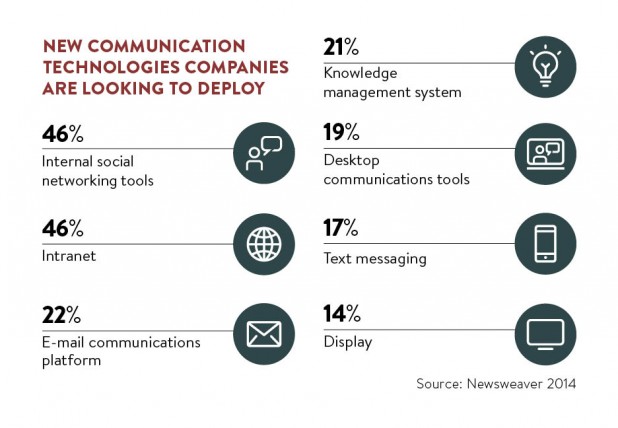Many employee engagement initiatives fail not because of poor design, but due to ineffective communication with employees. Nor is this confined to specific initiatives; any business wanting to increase engagement needs to make sure they have a suitable means of communicating with employees.
In theory this has been made easier by a number of developments in recent years, notably social media platforms, with employers developing their own internal channels to share information and allow employees to interact with each other in a way that is not possible with top-down communications.
Enabling the flow of communication
Tony Nicholls, managing consultant at White Stone OD, says one advantage of this is it can bypass the reliance on middle managers, who often fail to cascade messages down the organisation.
“It allows planned internal communications to flow around organisations in a way that mirrors how unplanned, organic communications naturally occur and spread,” he says. Yammer is the most popular channel, although data-sharing platforms such as Sharepoint are popular among particular groups of employees.
Organisations need to reflect the diverse demographics of their employee population and think about how people engage with technology outside the workplace
Havas Media Group is currently looking at introducing a social media element to its internal communications. “Organisations need to reflect the diverse demographics of their employee population and think about how people engage with technology outside the workplace through Twitter, Snapchat and Facebook,” says Darren Minshall, UK group chief talent officer at Havas Media. “An internal communications strategy needs to be implemented to build on these methods of communication, not just create new ones.”
The use of social media can be something of a double-edged sword, however, warns Chris Barrington, managing director of employee communication agency blue goose. “These platforms have enabled employees to communicate, and access each other – and information – easily and whenever and wherever they want,” he says. “Information now flows through many channels that the organisation cannot control.”
Leveraging the power of apps
This only increases the pressure on employers to find effective ways of reaching employees, and the rise of mobile technology has also helped, allowing people to access company intranets, social media platforms or dedicated apps from their own devices.
“The ability to communicate with employees 24/7 in real time via mobile is very compelling, especially as more employees are now willing to receive work messages on their personal smartphone,” says Jenny Perkins, head of engagement at Cirrus. “But it’s best to do this in a controlled environment such as an app. This helps to separate work life and personal life, and makes it easier for the employee to switch off.”
Such apps can be used to update people on important news as it happens. “By leveraging the right mobile app, employers can engage with their employees and give them the information they need on the go,” says James Kelly, head of sales at P&MM Employee Benefits. “One of the key benefits is the ability to send push notifications to ensure employees are always aware of the latest updates.”

This is something Opus Energy has used to good effect. “A favourite of our team is the Slack app,” says Lynn Morrison, head of business engagement. “With desktop, browser-based and mobile app versions, our teams can keep in touch anytime and anywhere they want.”
HCL Technologies is using both social media and mobile technology to help improve internal communication. Its mobile MEME platform connects more than 87,000 employees, says Prithvi Shergill, chief human resources officer, with the aim of getting them to connect with each other as well as to perform HR-related tasks such as entering timesheets or applying for holiday.
This has also led to a rise in engagement. “As soon as it was launched, MEME enabled us to collect more than 930 business innovation ideas from employees working on diverse projects across our organisation,” says Mr Shergill. “Around a fifth of those are now a part of HCL’s go-to-market offerings, demonstrating a clear business case for the role of social platforms in internal communications.”
[embed_related]
Enabling interaction
The use of social media and mobile technologies also allows both employees and employers to engage in real-time feedback rather than having to wait until an annual appraisal or meeting. “If a colleague gives a great presentation and someone commends them on that, this feedback is visible even to their line manager even if they didn’t actually see the presentation,” says Karen Minicozzi, vice president of human capital management product strategy for Europe, the Middle East and Africa at Workday.
Indeed, today’s employees now expect such immediate interaction and communication with their employers, making it essential for businesses wishing to build genuine rapport. “The paradigm has shifted from a traditional downwards periodic communication to employees, who expect both a real conversation and the empowerment to make change happen,” says Sam Dawson, UK head of insight at Korn Ferry Hay Group.
But there is a risk of relying exclusively on such technology. Jack Curzon, senior consultant at Thomsons Online Benefits, says he is seeing clients moving away from mobile apps. “Employees aren’t willing to download an application for something that they might use only once a week or once a month,” he says. “Instead it’s becoming more important to host information on a reactive, mobile-optimised website.” Tailoring communications for individual employees or groups is also important, he adds.
Robin Hames, head of marketing and research at Capita Employee Benefits, also warns against rejecting e-mail as a form of communication. “E-mail is firmly embedded in workplace communications, whereas the use of social media has been more hesitant,” he says. “We’re not yet seeing the full adoption of these channels in the same way as we have with e-mail.”
Enabling the flow of communication
Leveraging the power of apps

